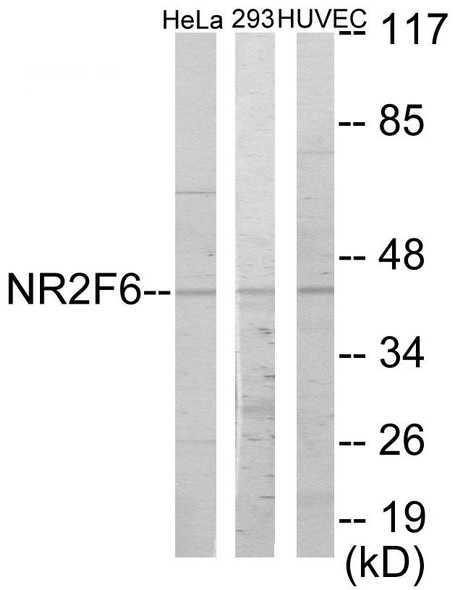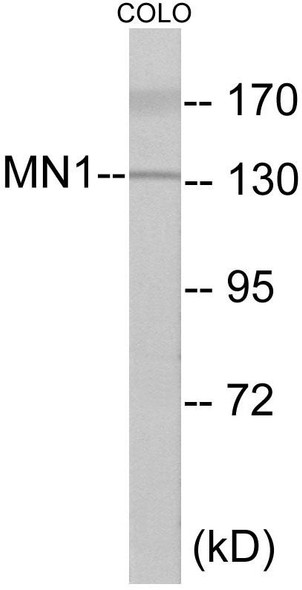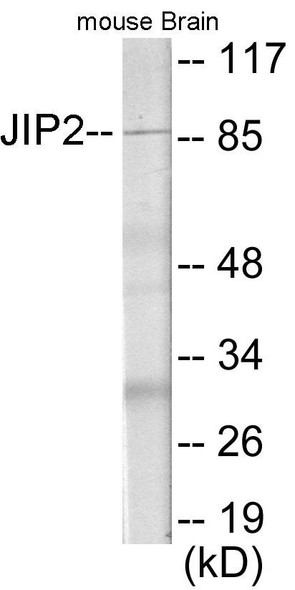Description
FOXL1 Colorimetric Cell-Based ELISA
The FOXL1 Colorimetric Cell-Based ELISA Kit is a cutting-edge assay designed for the precise measurement of FOXL1 levels in cell cultures. This kit offers exceptional sensitivity and specificity, guaranteeing accurate and consistent results for a variety of research purposes.FOXL1 is a key transcription factor that plays a vital role in various cellular processes, including cell differentiation and tissue development. Dysregulation of FOXL1 has been linked to several diseases, such as cancer and gastrointestinal disorders, underscoring its significance as a potential biomarker for disease detection and therapeutic development.
With its advanced technology and reliable performance, the FOXL1 Colorimetric Cell-Based ELISA Kit is an invaluable tool for researchers seeking to unravel the intricate mechanisms of FOXL1 and its impact on health and disease.
| Product Name: | FOXL1 Colorimetric Cell-Based ELISA |
| Product Code: | CBCAB01077 |
| ELISA Type: | Cell-Based |
| Target: | FOXL1 |
| Reactivity: | Human |
| Dynamic Range: | > 5000 Cells |
| Detection Method: | Colorimetric 450 nmStorage/Stability:4°C/6 Months |
| Format: | 96-Well Microplate |
The FOXL1 Colorimetric Cell-Based ELISA Kit is a convenient, lysate-free, high throughput and sensitive assay kit that can detect FOXL1 protein expression profile in cells. The kit can be used for measuring the relative amounts of FOXL1 in cultured cells as well as screening for the effects that various treatments, inhibitors (ie siRNA or chemicals), or activators have on FOXL1.
Qualitative determination of FOXL1 concentration is achieved by an indirect ELISA format. In essence, FOXL1 is captured by FOXL1-specific primary antibodies while the HRP-conjugated secondary antibodies bind the Fc region of the primary antibody. Through this binding, the HRP enzyme conjugated to the secondary antibody can catalyze a colorimetric reaction upon substrate addition. Due to the qualitative nature of the Cell-Based ELISA, multiple normalization methods are needed:
| 1. | A monoclonal antibody specific for human GAPDH is included to serve as an internal positive control in normalizing the target absorbance values. |
| 2. | Following the colorimetric measurement of HRP activity via substrate addition, the Crystal Violet whole-cell staining method may be used to determine cell density. After staining, the results can be analysed by normalizing the absorbance values to cell amounts, by which the plating difference can be adjusted. |
| Database Information: | Gene ID: 2300, UniProt ID: Q12952, OMIM: 603252, Unigene: Hs.533830 |
| Gene Symbol: | FOXL1 |
| Sub Type: | None |
| UniProt Protein Function: | FOXL1: Transcription factor required for proper proliferation and differentiation in the gastrointestinal epithelium. Target gene of the hedgehog (Hh) signaling pathway via GLI2 AND GLI3 transcription factors. |
| UniProt Protein Details: | Protein type:DNA-binding Chromosomal Location of Human Ortholog: 16q24 Cellular Component: nucleus Molecular Function:DNA binding; sequence-specific DNA binding; DNA bending activity; transcription factor activity Biological Process: regulation of transcription from RNA polymerase II promoter; transcription from RNA polymerase II promoter; organ morphogenesis; heart development; proteoglycan biosynthetic process; multicellular organismal development; regulation of Wnt receptor signaling pathway; visceral mesoderm-endoderm interaction involved in midgut development |
| NCBI Summary: | This gene encodes a member of the forkhead/winged helix-box (FOX) family of transcription factors. FOX transcription factors are characterized by a distinct DNA-binding forkhead domain and play critical roles in the regulation of multiple processes including metabolism, cell proliferation and gene expression during ontogenesis. [provided by RefSeq, Nov 2012] |
| UniProt Code: | Q12952 |
| NCBI GenInfo Identifier: | 13638268 |
| NCBI Gene ID: | 2300 |
| NCBI Accession: | Q12952.2 |
| UniProt Secondary Accession: | Q12952,Q17RR1, Q9H242, |
| UniProt Related Accession: | Q12952 |
| Molecular Weight: | 345 |
| NCBI Full Name: | Forkhead box protein L1 |
| NCBI Synonym Full Names: | forkhead box L1 |
| NCBI Official Symbol: | FOXL1 |
| NCBI Official Synonym Symbols: | FKH6; FKHL11; FREAC7 |
| NCBI Protein Information: | forkhead box protein L1; forkhead-like 11; forkhead-related protein FKHL11; forkhead-related transcription factor 7 |
| UniProt Protein Name: | Forkhead box protein L1 |
| UniProt Synonym Protein Names: | Forkhead-related protein FKHL11; Forkhead-related transcription factor 7; FREAC-7 |
| Protein Family: | Forkhead box protein |
| UniProt Gene Name: | FOXL1 |
| UniProt Entry Name: | FOXL1_HUMAN |
| Component | Quantity |
| 96-Well Cell Culture Clear-Bottom Microplate | 2 plates |
| 10X TBS | 24 mL |
| Quenching Buffer | 24 mL |
| Blocking Buffer | 50 mL |
| 15X Wash Buffer | 50 mL |
| Primary Antibody Diluent | 12 mL |
| 100x Anti-Phospho Target Antibody | 60 µL |
| 100x Anti-Target Antibody | 60 µL |
| Anti-GAPDH Antibody | 60 µL |
| HRP-Conjugated Anti-Rabbit IgG Antibody | 12 mL |
| HRP-Conjugated Anti-Mouse IgG Antibody | 12 mL |
| SDS Solution | 12 mL |
| Stop Solution | 24 mL |
| Ready-to-Use Substrate | 12 mL |
| Crystal Violet Solution | 12 mL |
| Adhesive Plate Seals | 2 seals |
The following materials and/or equipment are NOT provided in this kit but are necessary to successfully conduct the experiment:
- Microplate reader able to measure absorbance at 450 nm and/or 595 nm for Crystal Violet Cell Staining (Optional)
- Micropipettes with capability of measuring volumes ranging from 1 µL to 1 ml
- 37% formaldehyde (Sigma Cat# F-8775) or formaldehyde from other sources
- Squirt bottle, manifold dispenser, multichannel pipette reservoir or automated microplate washer
- Graph paper or computer software capable of generating or displaying logarithmic functions
- Absorbent papers or vacuum aspirator
- Test tubes or microfuge tubes capable of storing ≥1 ml
- Poly-L-Lysine (Sigma Cat# P4832 for suspension cells)
- Orbital shaker (optional)
- Deionized or sterile water
*Note: Protocols are specific to each batch/lot. For the correct instructions please follow the protocol included in your kit.
| Step | Procedure |
| 1. | Seed 200 µL of 20,000 adherent cells in culture medium in each well of a 96-well plate. The plates included in the kit are sterile and treated for cell culture. For suspension cells and loosely attached cells, coat the plates with 100 µL of 10 µg/ml Poly-L-Lysine (not included) to each well of a 96-well plate for 30 minutes at 37°C prior to adding cells. |
| 2. | Incubate the cells for overnight at 37°C, 5% CO2. |
| 3. | Treat the cells as desired. |
| 4. | Remove the cell culture medium and rinse with 200 µL of 1x TBS, twice. |
| 5. | Fix the cells by incubating with 100 µL of Fixing Solution for 20 minutes at room temperature. The 4% formaldehyde is used for adherent cells and 8% formaldehyde is used for suspension cells and loosely attached cells. |
| 6. | Remove the Fixing Solution and wash the plate 3 times with 200 µL 1x Wash Buffer for five minutes each time with gentle shaking on the orbital shaker. The plate can be stored at 4°C for a week. |
| 7. | Add 100 µL of Quenching Buffer and incubate for 20 minutes at room temperature. |
| 8. | Wash the plate 3 times with 1x Wash Buffer for 5 minutes each time. |
| 9. | Add 200 µL of Blocking Buffer and incubate for 1 hour at room temperature. |
| 10. | Wash 3 times with 200 µL of 1x Wash Buffer for 5 minutes each time. |
| 11. | Add 50 µL of 1x primary antibodies (Anti-FOXL1 Antibody and/or Anti-GAPDH Antibody) to the corresponding wells, cover with Parafilm and incubate for 16 hours (overnight) at 4°C. If the target expression is known to be high, incubate for 2 hours at room temperature. |
| 12. | Wash 3 times with 200 µL of 1x Wash Buffer for 5 minutes each time. |
| 13. | Add 50 µL of 1x secondary antibodies (HRP-Conjugated AntiRabbit IgG Antibody or HRP-Conjugated Anti-Mouse IgG Antibody) to corresponding wells and incubate for 1.5 hours at room temperature. |
| 14. | Wash 3 times with 200 µL of 1x Wash Buffer for 5 minutes each time. |
| 15. | Add 50 µL of Ready-to-Use Substrate to each well and incubate for 30 minutes at room temperature in the dark. |
| 16. | Add 50 µL of Stop Solution to each well and read OD at 450 nm immediately using the microplate reader. |
(Additional Crystal Violet staining may be performed if desired – details of this may be found in the kit technical manual.)






